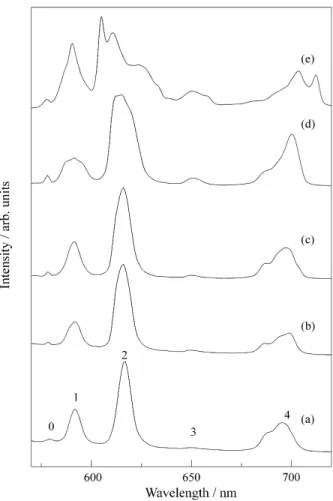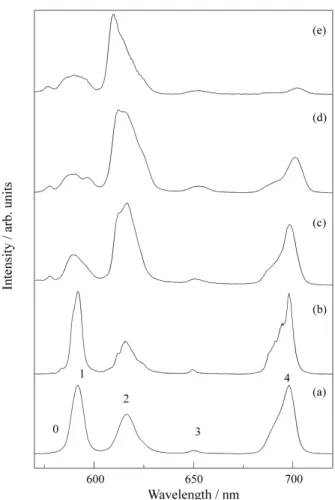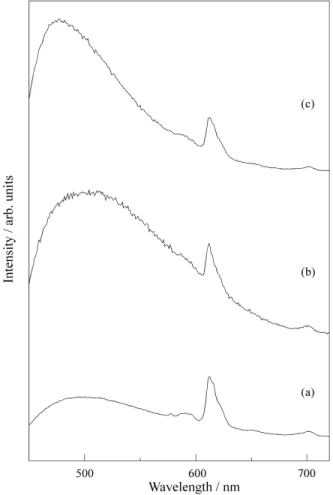Optical Properties of ZrO
2, SiO
2and TiO
2-SiO
2Xerogels and
Coatings Doped with Eu
3+and Eu
2+Rogéria R. Gonçalves, Younes Messaddeq, Mohamed Atik,
Sidney J.L. Ribeiro
Instituto de Química Universidade Estadual Paulista C.P. 355, 14801-970 Araraquara- SP, Brazil;
e-mail: sidney@iq.unesp.br
Received: March 24, 1998 Revised: November 6, 1998
Eu3+ doped bulk monoliths and thin films were obtained by sol-gel methods in the ZrO2, SiO2
and SiO2-TiO2 systems. Eu3+5D0→7FJ emission and decay time characteristics were measured
during the entire experimental preparation route from the initial sol to the final xerogels. The crystalline phases identified were tetragonal ZrO2 and mixtures of rutile and anatase TiO2 at high
temperature treatments in bulk samples. Good quality thin films were obtained for all systems by dip-coating optical glasses (Schott BK270). The same spectroscopic features were observed either for the bulk monoliths or the films. By appropriate heat treatments under H2 atmosphere Eu2+
containing samples could be obtained in the SiO2-TiO2 system.
Keywords:rare earths, Eu3+ spectroscopy, silica, titania, zirconia, thin films
1. Introduction
Despite the large number of papers dealing with the sol-gel preparation of rare earth containing materials either in the form of bulk monoliths or thin films, relatively few of them deal with the influence of the rare earth neighbour-hood on the optical properties and its evolution with the materials preparation. Er3+ and Nd3+ doped materials have been mostly studied mainly due to their technologically important emission lines in the infrared region of the elec-tromagnetic spectrum1. Sm2+ systems have also been inves-tigated due to their hole burning characteristics2.
Eu3+ ions have been added to SiO
23-8, SnO2 9-12 and TiO213-15 with the main goal to understand the structural features well reflected in the observed spectroscopic char-acteristics.
In this work we investigate the Eu3+ spectral changes as a function of the experimental preparation route in SiO2, SiO2-TiO2 and ZrO2 prepared by a sol-gel method. The materials were obtained as xerogel monoliths, powders or thin films deposited on glass substrates by the dip-coating
technique. Some preliminary results in the reduction Eu3+
→ Eu2+ are also presented.
2. Experimental
2.1. ZrO2
Zirconium isopropoxide Zr(OC3H7)4 was dissolved in isopropanol followed by addition of acetic acid. The solu-tion was then treated with ultrasonic irradiasolu-tion during 20 min. Water or Europium Chloride solution (0.1 M) were added and a clear and transparent sol was obtained. The molar ratio alkoxide:acetic acid:water was 1:7.8:24.8. Samples with 2.7%, 5.4% and 8.1% Eu (mol%) could be prepared.
2.2. SiO2
Tetraethil orthosilicate TEOS was diluted in ethanol followed by addition of acetic acid and hydrochloric acid solution (0.1 M), under ultrasonic irradiation. The molar ratio alkoxide:acetic acid: hydrochloric acid solution was 1:4:0.2.Clear sols containing 1.4%, 2.7% and 4.1% (%mol) Eu3+ were prepared.
2.3. SiO2-TiO2
TEOS was diluted in ethanol followed by addition of acetic acid under ultrasonic irradiation. Titanium ethoxide was then added followed by addition of methanolic solu-tion of europium chloride and hydrochloric acid solusolu-tions. The molar ratio TEOS: Titanium ethoxide: acetic acid was 1:0.62:1.3. Clear sols containing 0.5% mol Eu3+ were pre-pared.
2.4. Thin films
Were obtained by dip-coating technique. Optical glass (Schott-BK270) slides (25 mm x 10 mm) were carefully cleaned, sunk in the sols and then withdrawn at a rate of 100 mm/min (for SiO2-TiO2 better depositions were achieved at 50 mm/min). The coated substrates were dried for about 15 min at room temperature and then heat treated at 500 °C . The homogeneity of the compositions and thickness were checked by scanning electron microscopy and energy dispersive X-ray (EDX) analysis.
2.5. Gels and Xerogels
Bulk monoliths were obtained drying the sols at room temperature (≈25 °C) . In general zirconia sols gelify in 2-3 months. Silica and silica-titania systems gelify in 1-2 weeks. The monoliths were then further heat treated at 120, 500, 600, 800 and 950 °C. Some samples were also heat treated under H2 atmosphere at 800 °C for 5, 10 and 24 h.
2.6. Optical and structural properties
Room temperature excitation and emission spectra were obtained under both continuous (450 W) and pulsed (5 mJ/pulse, 3 µs bandwidth) Xe lamps excitation with a SPEX Fluorolog F212I spectrofluorimeter. The spectra were all corrected for spectrometer optics, lamps output and detector response, and were obtained with typically 1nm bandwidth. Decay curves were processed with the SPEX 1934 phosphorimeter. X-ray diffractograms were obtained with a Siemens D5000 X-ray Diffractometer. Electron Microscopy (MEV) and chemical analysis (en-ergy dispersive X-ray analysis) were performed with a ZEISS DSM960 Microscope.
3. Results and Discussions
Clear sols were obtained for all systems studied. With drying at room temperature, transparent monolithic xero-gels could be obtained with typically 1 cm diameter in size. At 500 °C, SiO2 and SiO2-TiO2 transparent monoliths were still obtained. ZrO2 pieces appear grey in colour. Higher temperatures treatments gave transparent silica pieces and white ones for SiO2-TiO2 and ZrO2.
Homogeneous films with the same compositions as the nominal ones have been obtained from dip coating.
Thick-ness in the range between 0.5 and 1 µm were routinely obtained for the 3 systems.
Figure 1 shows room temperature Eu3+ emission spec-tra, obtained throughout the experimental preparation route, from the stable sol to the xerogel heat treated at 950 °C, for the samples containing 8.1 mol% Eu3+ in the ZrO2 system. No significant changes were observed for samples with lower Eu3+ concentrations. The spectra were obtained by exciting the 5L6 level of the Eu3+ 4f6 configu-ration at 394 nm. One observes emission transitions arising mainly from the 5Do level to the 7FJ (J = 0-4) manifolds and similar spectra were observed for the starting sol (Fig. 1(a)) and the transparent wet gel (Fig. 1(b)). Eu3+ ions seem to strongly interact with the large scale polymeric chain net-works assumed to exist in the zirconia colloidal system16. This feature is observed even for the initial sol, contrary to what is observed in silica systems where Eu3+ neighbouring is considered to be water-like in nature3-8.
Figure 1. Eu3+5D0 emission spectra in the ZrO2 system (8% mol Eu3+ ) under 5L6 excitation (395 nm). (a) Sol (τ (5D0)= 0.52 ms); (b) Wet gel (τ
(5D0) = 0.52 ms); (c) Dried gel 50 °C (τ (5D0) = 0.52 ms); (d) Dried gel
130 °C (τ (5D0) = 0.84 ms) and (e) Xerogel 950 °C (τ (5D0) = 3.57 ms).The numbers refer to the J values of the final level of the emission transitions
5
Eu3+5D0 measured lifetimes values are presented in the caption of the figure. Considering only radiative and non-radiative processes involved in the 5D0 excited state de-population, the rates for these two processes were evaluated from the measured decay times and transition intensities. The transition occurring at ≈590 nm (5D0→7F1) is known to be magnetic dipolar in character and therefore does not depend on the matrix nature. It can be taken as a reference (Arad = 50 s-1 where Arad is the spontaneous emission coefficient). The total radiative rate was estimated by con-sidering the intensities ratios between this transition and the other ones arising from the 5D0 level. The non-radiative transitions obtained with this procedure could then be related mainly to multiphonon processes through OH os-cillators of water molecules in the first coordination sphere of the Eu3+ ions4,5. From the results presented in the caption of Fig. 1 it is clear that the non-radiative decays become less and less important upon heating the samples. After a 120 °C heat treatment the emission spectrum closely resem-bles spectra obtained for Eu3+ containing oxide glasses, where the lines are inhomogeneously broadened and fully splitted3-12. At this stage the samples loose their transpar-ency although no crystalline phase could be detected by X-rays diffraction. If one relates the measured lifetimes with the number of coordinated water molecules17 the sample dried at 90 °C (τ = 0.84 ms) would present only one molecule of water for each Eu3+ ion. These results are largely encouraging regarding technological applications where water molecules are not welcome.
In zirconia systems the crystallisation process is known to occur at 500 °C18. All our samples heat treated at 500 °C became black, probably because of incomplete burning of organic residues, hindering spectroscopic measurements to be made. By Increasing the temperature the samples be-came white powders and by X-ray diffraction we could identify the tetragonal ZrO2 phase. At our knowledge there is no study on the limits of solubility for Eu3+ in this phase. As X-ray diffraction did not revealed other crystalline phase, we speculate at this stage that spectrum (e) in Fig. 1 is related to the Eu3+ doped tetragonal ZrO2.
Figure 2 presents Eu3+ emission spectra for the sol, gel and heat treated samples in the SiO2 system. Contrary to what was observed in the zirconia systems, good optical quality, transparent samples could be obtained for heat treatment temperatures up to 800 °C. This system is well studied in the literature, and our results agree with the previous published results3-8. The emission spectrum and the Eu3+5D0 decay time (τ = 0.14 ms) obtained for the sol, are similar to the results observed for Eu3+ in water, and are a clear indication of a water-like neighbouring. With gela-tion the spectrum hardly changes and the decay time in-creased to 0.26 ms, reflecting water losses.
For the sample heat treated at 120 °C the intensities ratio between the hypersensitive 5D0→7F2 transition (≈620 nm) and the magnetic dipolar 5D0→7F1 increases drastically and an inhomogeneous broadening typical of oxide glasses is observed which is a clear indication of lower symmetry for the Eu3+ surroundings. 1.2 neighbouring water mole-cules may be inferred from the decay time results (τ = 0.70 ms). The broadening of emission lines is still increased with 500 °C treatment (Fig. 2(d)) and from the Eu3+5Do decay time of 1.35 ms the number of OH oscillators at the Eu3+ surrounding may be estimated to be < 0.4. No crystalline phase could be detected.
Figure 2 also displays the emission spectrum obtained for the film submitted to the same 500 °C heat treatment (Fig. 2(e)). It shows differences in comparison with the spectrum obtained for the bulk sample mainly related to the relative transition intensity of the 5D0→7F4 transition at about 700 nm. The 5Do measured decay time of 1.35 ms is the same of the one obtained for bulk sample.
Figure 2. Eu3+ 5D0 emission spectra in SiO2 system under 5L6 excitation
(395 nm). (a) Sol (τ (5D0) = 0.14 ms); (b) Wet gel (τ (5D0) = 0.26 ms); (c)
Dried gel 120 °C (τ (5D0) = 0.70 ms); (d) Dried gel 500 °C (τ (5D0) = 1.35 ms) and (e) Dried film 500 °C (τ (5D0) = 1.35 ms). The labels refer to the
Figure 3 displays Eu3+ the emission spectra obtained for the system SiO2-TiO2. As for SiO2 systems sol and wet gel present Eu3+ spectra very similar to the one observed for the aqua ion3-8 although decay times suggest about 4 water molecules for the Eu3+ surroundings. With heat treatments the structural changes are more spectacular than those observed in silica. The relative increase in intensity for the hypersensitive 5D0→7F2 is more important and the meas-ured decay times are considerably longer. The same fea-tures are observed for the films (Fig. 3(c)). All these features must be related with the enhanced interactions of Eu3+ ions and the colloidal SiO2-TiO2 particles compared with the SiO2.
An 800 °C heat treatment results in the crystallisation of a mixture of rutile and anatase TiO2 , as revealed by X-ray diffraction. Eu3+ seems to segregate in different phases as different emission spectra could be obtained just by changing the excitation wavelength. Figure 3 (d)
pre-sents the spectrum obtained by excitation at 395 nm. This spectrum is very similar to the one obtained for the samples heat treated at lower temperatures, indicating Eu3+ ions statistically distributed in an amorphous matrix. Decay times could not be fitted by a single exponential law. Instead, the contribution of at least two components was necessary to well fit the curves. In the caption of the Fig. 3(d) decay times for these two components are denoted τ1 and τ2. By changing the excitation wavelength to 340 nm a completely different spectrum is obtained as shown in Fig. 3(e). The increased decay time and the reduced band-widths suggest the presence of Eu3+ in one of the crystalline phases detected by the X-ray diffraction. Further measure-ments are needed to completely characterise the Eu3+ neighbouring in this composite matrix.
Figure 4 shows the results obtained for some Eu3+ reduction experiments under N2/H2 atmosphere, for the SiO2-TiO2 system. Eu2+ may be easily identified by the broad emission band observed at around 500 nm and as-signed to the 4f65d → 4f7 electronic transition. An increase in Eu2+ concentration is observed with longer treatments.
Figure 3. Eu3+5D0 emisson spectra in the SiO2-TiO2 system (0.5% mol
Eu3+). (a) Wet gel (τ (5D0) = 0.24 ms); (b) Dried gel 130 °C (τ (5D0) = 0.92 ms); (c) Dried film 500 °C (τ (5D0) = 2.40 ms); (d) Dried gel 800 °C (τ1 (5D0) = 1.80 ms; τ2 (5D0) = 2.35 ms) obtained under excitation at 5L6
level (395 nm) and (e) Dried gel 800 °C (τ = 1.80 ms) (excitation at 340 nm). The labels refer to the J values of the final level of the emission transitions 5D0→7FJ.
Figure 4. Eu3+,2+ emission spectra in SiO2-TiO2 (0.5% mol Eu3+ )
However, as the figure shows, a mixture of Eu3+ and Eu2+ is always obtained for treatments up to 24 h.
4. Conclusions
Clear gels containing Eu3+ have been obtained by the sol-gel process in the systems ZrO2, SiO2 and SiO2-TiO2. Eu3+ characteristic luminescence spectra have been meas-ured after all processing steps.
In the case of silica and silica-titania systems a water like environment could be suggested for the Eu3+ neigh-bourhood in the initial sol and the wet gel. Spectra typical of silica glasses were obtained for silica xerogels treated at 500 °C with a 5D0 level lifetime of 1.35 ms. For the silica-titania system the same observations could be done for heat treatments up to 500 °C. However a longer lifetime for the 5
D0 level is observed (τ = 2.40 ms) denoting the enhanced interaction betwen Eu3+ ions and the colloidal matrix. The crystallization of a mixture of rutile and anatase TiO2 is observed for 800 °C treatments. Eu3+ ions segregate in different phases as indicated by emission spectra.
In zirconia systems Eu3+ strongly interacts with the colloidal particles even in the initial sol. After 120 °C treatment spectra typical of oxide glasses are obtained.
The long 5D0 decay times obtained after appropriate heat treatments suggest that low multiphonon decay for Eu3+ excited states are achieved in low phonon oxides such as ZrO2 or TiO2.
Good optical quality films were obtained for these systems and the easy for eliminating water molecules from the lanthanide neighbourhood is largely encouraging for utilization in optical devices.
A mixture of Eu3+ + Eu2+ was obtained from Eu3+ samples for preliminar experiments with heat treatments up to 24 h long under H2/N2 atmosphere.
Acknowledgments
The authors acknowledge FAPESP, CNPq and PRONEX (Brazilian agencies) for financial support.
References
1. Barbier, D.; Orignac, X.; Du, X.M.; Almeida, R.M. J. of Sol-Gel Science and Technology, v. 8, p. 1013, 1997.
2. Nogami, M.; Abe, Y. J. of Sol-Gel Science and Tech-nology, v. 8, p. 867, 1997.
3. Levy, D.; Reisfeld, R. ; Avnir, D. Chem. Phys. Lett, v. 109, p. 593, 1984.
4. Campostrini, R.; Carturan, G.; Ferrari, M.; Montagna, M.; Pilla, O. J. Mater. Res., v. 7, n. 3, p. 745, 1992. 5. Ferrari, M.; Campostrini, R.; Carturan, J., Montagna,
M. Philosophical Magazine B, v. 65, n. 2, p. 251-260, 1992.
6. McDonagh, C.; Ennis, G.; Marron, P.; Kelly, B.O’; Tang, Z.R.; McGilp, J.F. Journal of Non-Cryst. Sol., v. 147/148, p. 97-101, 1992.
7. Lochhead, M.J.; Bray, K.L. Chem. Mat., v. 7, p. 572-577, 1995.
8. Nogami, M.; Abe, Y. Journal of Non-Cryst. Sol., n. 197,p. 73-78, 1996.
9. Ribeiro, S.J.L.; Hiratsuka, R.S.; Massabni, A.M.G.; Davolos, M.R.; Santilli, C.V.; Pulcinelli, S.H. J. of Non-Cryst. Sol., v. 147/148, p. 162-166, 1992. 10. Ribeiro, S.J.L.; Pulcinelli, S.H. ; Santilli, C.V. Chem.
Phys. Lett., n. 190, p. 164, 1992.
11. Ribeiro, S.J.L.; Santilli, C.V.; Pulcinelli, S.H.; Fortes, F.L.; Oliveira, L.F.C. J. of Sol-Gel Science and Tech-nology, n. 2, p. 263-267, 1994.
12. Brito, G.E.S.; Ribeiro, S.J.L.; Briois, V.; Dexpert-Ghys, J.; Santilli, C.V.; Pulcinelli, S.H. J. of Sol-Gel Science and Technology, v. 8, n. 1/2/3, p. 261, 1997. 13. Guizard, C.; Achddou, J.C.; Larbot, A.; Cot, L.;
Le-Flem, G.; Parent, C.; Lurin, C. SPIE v. 1328 Sol-Gel Optics, 208, 1990.
14. Bouazaoui, M.; Bahtat, M.; Bahtat, A.; Mugnier, J.
Journal de Physique IV, Col. C4, Sup. Journal de Physique III, v. 4, C4-341, 1994.
15. Bahtat, M. Thesys, Universite Claude Bernard, Lyon - France, 1996.
16. Cahumont, D.; Craievich, A.; Zarzycki, J. J. of Non-Cryst. Solids, v. 147/148, p. 41-46, 1992.
17. Horrocks Jr., W.W.; Sudnick, D. J. of the American Chemical Society, v. 101, n. 2, p. 334, 1979.


